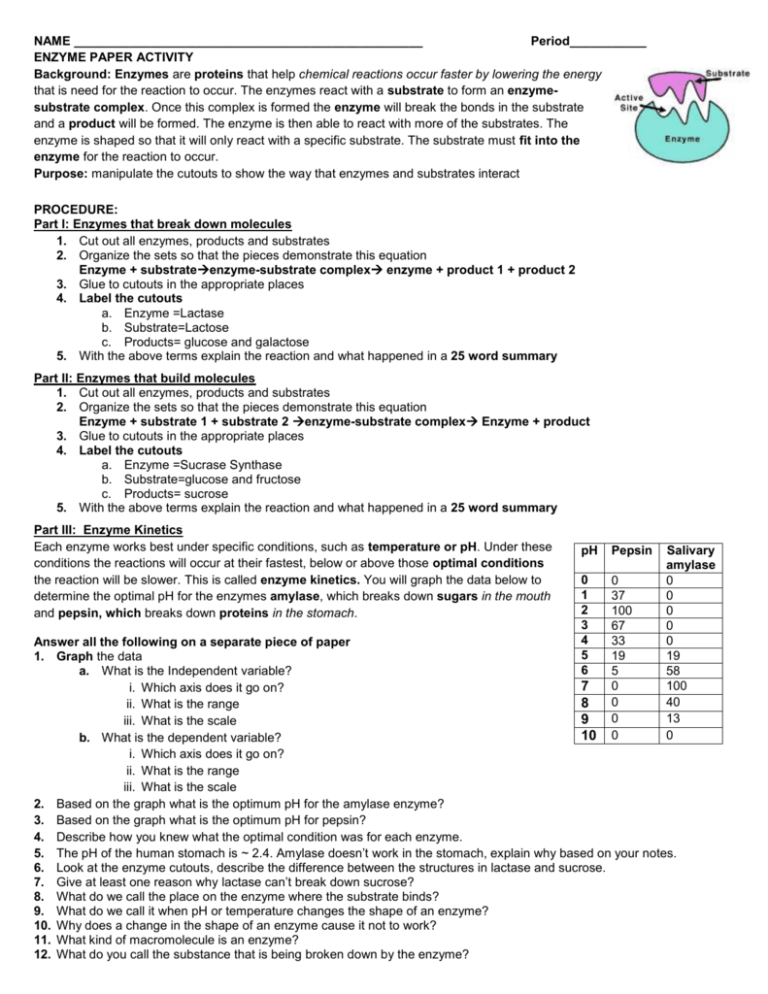Enzyme Activity Worksheet: Enzyme Kinetics & Interactions
advertisement

NAME __________________________________________________ Period___________ ENZYME PAPER ACTIVITY Background: Enzymes are proteins that help chemical reactions occur faster by lowering the energy that is need for the reaction to occur. The enzymes react with a substrate to form an enzymesubstrate complex. Once this complex is formed the enzyme will break the bonds in the substrate and a product will be formed. The enzyme is then able to react with more of the substrates. The enzyme is shaped so that it will only react with a specific substrate. The substrate must fit into the enzyme for the reaction to occur. Purpose: manipulate the cutouts to show the way that enzymes and substrates interact PROCEDURE: Part I: Enzymes that break down molecules 1. Cut out all enzymes, products and substrates 2. Organize the sets so that the pieces demonstrate this equation Enzyme + substrateenzyme-substrate complex enzyme + product 1 + product 2 3. Glue to cutouts in the appropriate places 4. Label the cutouts a. Enzyme =Lactase b. Substrate=Lactose c. Products= glucose and galactose 5. With the above terms explain the reaction and what happened in a 25 word summary Part II: Enzymes that build molecules 1. Cut out all enzymes, products and substrates 2. Organize the sets so that the pieces demonstrate this equation Enzyme + substrate 1 + substrate 2 enzyme-substrate complex Enzyme + product 3. Glue to cutouts in the appropriate places 4. Label the cutouts a. Enzyme =Sucrase Synthase b. Substrate=glucose and fructose c. Products= sucrose 5. With the above terms explain the reaction and what happened in a 25 word summary Part III: Enzyme Kinetics Each enzyme works best under specific conditions, such as temperature or pH. Under these conditions the reactions will occur at their fastest, below or above those optimal conditions the reaction will be slower. This is called enzyme kinetics. You will graph the data below to determine the optimal pH for the enzymes amylase, which breaks down sugars in the mouth and pepsin, which breaks down proteins in the stomach. pH Pepsin 0 1 2 3 4 5 6 0 37 100 67 33 19 5 0 0 0 0 Salivary amylase 0 0 0 0 0 19 58 100 40 13 0 Answer all the following on a separate piece of paper 1. Graph the data a. What is the Independent variable? 7 i. Which axis does it go on? 8 ii. What is the range 9 iii. What is the scale 10 b. What is the dependent variable? i. Which axis does it go on? ii. What is the range iii. What is the scale 2. Based on the graph what is the optimum pH for the amylase enzyme? 3. Based on the graph what is the optimum pH for pepsin? 4. Describe how you knew what the optimal condition was for each enzyme. 5. The pH of the human stomach is ~ 2.4. Amylase doesn’t work in the stomach, explain why based on your notes. 6. Look at the enzyme cutouts, describe the difference between the structures in lactase and sucrose. 7. Give at least one reason why lactase can’t break down sucrose? 8. What do we call the place on the enzyme where the substrate binds? 9. What do we call it when pH or temperature changes the shape of an enzyme? 10. Why does a change in the shape of an enzyme cause it not to work? 11. What kind of macromolecule is an enzyme? 12. What do you call the substance that is being broken down by the enzyme?



